Email marketing is a powerful tool for businesses to connect with their audience. However, convenience comes with the great responsibility of safeguarding the subscriber’s privacy and adhering to the laws of a specific country. Failing to understand and comply with these rules can result in penalties.
GDPR and ePrivacy Directives are mainly responsible for ensuring compliance with email marketing laws in the UK and Europe. Both regions rely heavily on consent, allowing easy opt-out, ensuring transparency, documenting communication, and implementing security in their email marketing practices.
In this guide, let’s look deeper at the email marketing laws of the UK and Europe.
Understanding GDPR for the UK and Europe
The GDPR (General Data Protection Regulations) was introduced in 2018 as data protection rules restricting organizations from using personal data.
Recognized as one of the strictest data privacy laws in the world, it imposes stringent regulations on entities involved in online communication.
Initially, the GDPR rules were applied uniformly across the UK and European countries.
However, following Brexit and the end of the transition period, the UK adopted its version of these regulations, known as the UK GDPR.
Despite the UK’s withdrawal from the EU, the UK and EU GDPR remain largely aligned, particularly concerning email marketing guidelines.
There are, however, some minor differences between the two. More on that later.
Note: Do check out my article on Email Marketing Laws for the US and Canada to know about those regions!
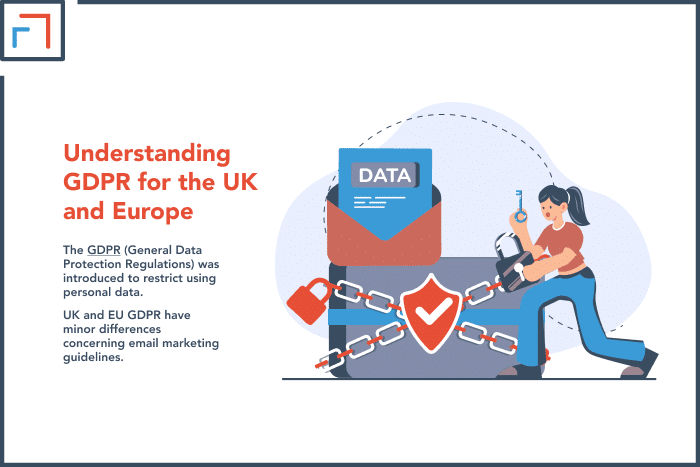
Key Strategies of Email Marketing Under GDPR
This section outlines key strategies to ensure that your email marketing campaigns are effective and fully compliant with GDPR.
Let’s dive into these strategies, starting with the most fundamental aspect: obtaining consent.
1. Take Consent
Getting permission before sending emails is legally and ethically required. The subscribers must freely give consent for communication. This means there should be no pre-checked boxes on an opt-in form.
Email marketers should also clearly describe the purpose of their email newsletters and how they will use the subscriber’s data.
2. Keep Proof of Record
According to the GDPR, every marketer seeking consent for email campaigns should keep a paper trail of how and when permission was obtained.
The records should also specify the information on what the individual consented to.
3. Allow Seamless Opt-Out
Marketers must promptly respond to unsubscribe requests from their recipients. The opt-out or unsubscribe button should be prominently displayed in every email.
The form should also be simple and free of charge, allowing the candidates to exit if they are not interested.
Additionally, if a subscriber opts out, the marketer must not bother them with further emails to re-subscribe.
Instead, they must follow a transparent ‘no-question’ asked policy and honor their requests immediately.
4. Don’t Retain Consumer Data
GDPR is against retaining consumers’ data for longer periods than necessary.
Ideally, this means only keeping data for as long as it serves the purpose for which it was collected, such as for the duration of a subscription or contract.
Keeping subscribers’ personal details when they are not in use is also a breach of their data privacy rights and can result in penalties.
To prevent unwanted trouble, delete any information you have about unsubscribed accounts.
It is also a good idea to refresh the data periodically, such as every six months, by asking users to re-engage before deleting their data.
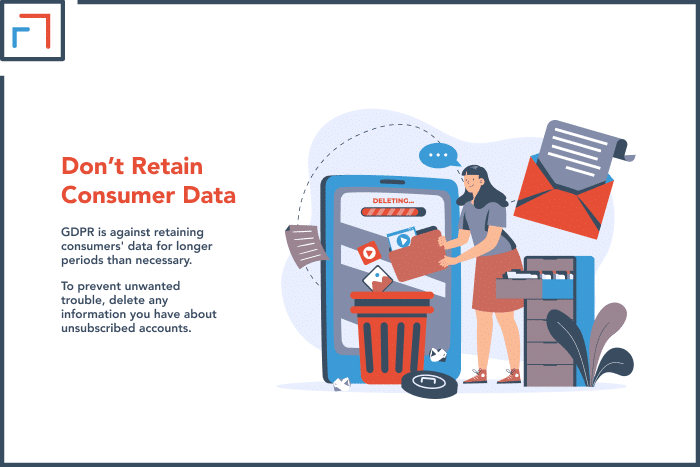
5. Ensure Transparency
Another requirement of the EU and UK GDPR is ensuring transparency. You should inform subscribers how their details will be processed within your database.
So, add a link to your privacy policy in all emails to inform the readers about your data collection policy.
6. Avoid Anonymity
Sending emails without accurate names and contact details is prohibited by the GDPR.
Even if you are sending a ‘no-reply’ message, a separate email address or phone number should be included so recipients can contact you if needed.
7. Refrain from ‘Buying’ Email Lists
It is a common practice for marketers to purchase email lists from brokers and utilize them for their marketing activities.
However, the GDPR prohibits the strategy unless each person on the list consented to receive promotional emails.
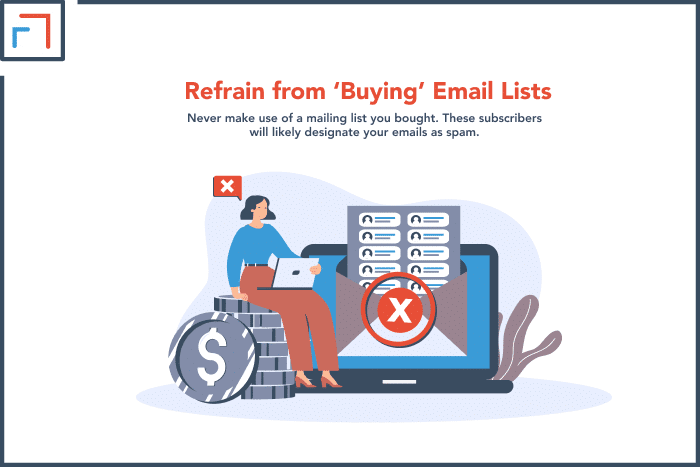
8. Ensure Robust Security
According to the bylaws of GDPR, emails should have: “…protection against unauthorized or unlawful processing and accidental loss, destruction, or damage, using appropriate technical or organizational measures.”
Some examples of such measures might include the following:
- Encryption of personal data
- Conducting regular security audits
- Restricting access to personal data to authorized personnel
- Having a robust incident response plan
GDPR is all about the consumers and safeguarding their privacy. So if you are investing in an email marketing software or storage system, ensure they are encrypted and provide maximum security.
Access to the data should only be allowed when necessary.
Moreover, if you are sending emails outside the UK and Europe, confirm that the recipient country offers adequate data protection.
Otherwise, implement strategic safeguard policies to maintain the privacy of data.
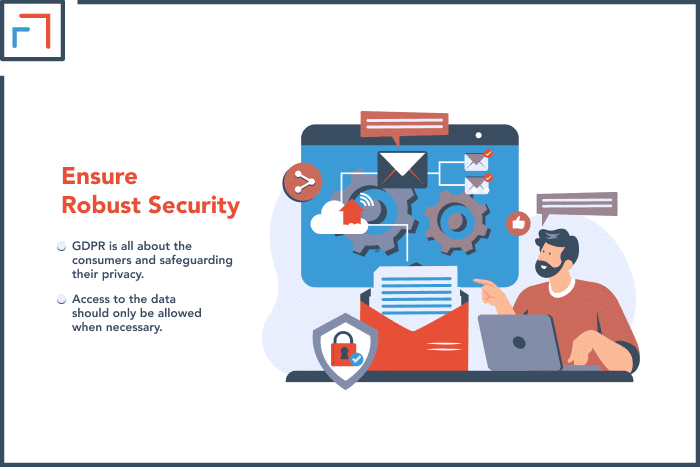
What Are the Consequences of Non-Compliance?
Failing to address the GDPR law by individuals and organizations can result in significant penalties and reputation damage.
The UK GDPR has set a maximum fine of £17.5 million. In the EU, GDPR sets a penalty of €20 million, approximately £18 million.
The penalties imposed depend on the nature of your violation and the severity of the damages. Severity might be assessed based on factors such as:
- The volume of data compromised
- The level of negligence involved
- The degree of harm caused to the individuals whose data was mishandled
Depending on the specifics of the violation, penalties can include:
- A warning
- A temporary or permanent ban from email communication
- Erasure of data
In 2022, the UK postal service Royal Mail was fined £20,000 for sending promotional emails to internet users who hadn’t consented to their subscription list.
This and many similar incidents serve as a reminder for us to comply with the GDPR practices closely.
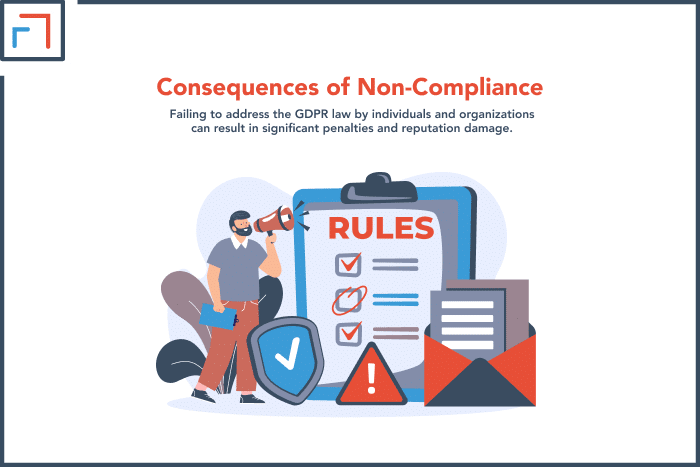
What is the ePrivacy Directive for Email Marketing?
The ePrivacy Directive is a rulebook for European countries and has placed additional guidelines for email marketing.
While GDPR focuses primarily on personal data, the ePrivacy Directive also considers non-personal data and cookies.
Non-personal data refers to data that cannot be used to identify an individual directly, and cookies are small files that websites place on visitors’ devices to track their activity and preferences.
The laws for the ePrivacy Directive are further distributed into new guidelines formed by each EU member state, adapting the Directive to their national context.
For the EU, it is evolving into the recently proposed ePrivacy Regulation, which is intended to replace the Directive and harmonize the laws across member states.
In the UK, following Brexit, the rules derived from the ePrivacy Directive are governed by the Privacy and Electronic Communications Regulations (PECR).
As per the rules of both entities, email marketers can include pixels and other technologies in their marketing emails only if people have given clear permission for them.
In summary, the ePrivacy Directive, and its subsequent national regulations, play a crucial role in dictating how email marketers in Europe can use technologies like pixels and cookies, emphasizing the need for clear user permission.
How Does the UK Email Marketing Law Differ from the EU?
Now let’s take an overview of the differences between the GDPR laws of Europe and the UK:
| Factor | EU GDPR | UK GDPR |
|---|---|---|
| Jurisdiction | The EU GDPR rules apply to all 27 EU member states. | Applies solely to the UK. |
| Location Applicability | Applies to all entities – inside and outside the EU if processing data of individuals in the EU. | Applies to organizations based in the UK or organizations outside the UK that process data of individuals in the UK. |
| Supervising Authorities | Each member state requires one or more supervisory authorities to monitor GDPR compliance. They are governed by the European Data Protection Board (EDPB), which oversees GDPR implementation. | The Information Commissioner’s Office (ICO) oversees the integration of data protection practices. |
| Consent Age | An individual must be 16 years or older to consent to the use of their data. | The minimum age for consent is 13. |
What about Data Transfer between the UK and the EU?
The UK is now a third country in the EU. However, both regions allow data to flow between them without additional rules. But note that this can change during the next review by the EU in 2025.
Conclusion
The email marketing laws in the UK and Europe are stringent compared to other countries. However, understanding the system and ensuring best practices can help you stay out of hot water.
Applying the right strategy to your email newsletters can also nurture trust, transparency, and a better relationship with your subscribers.
As you navigate these laws, you contribute to a digital environment that is safe and respectful for users.
